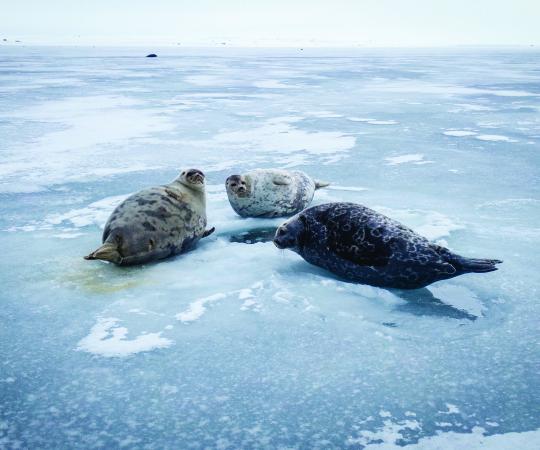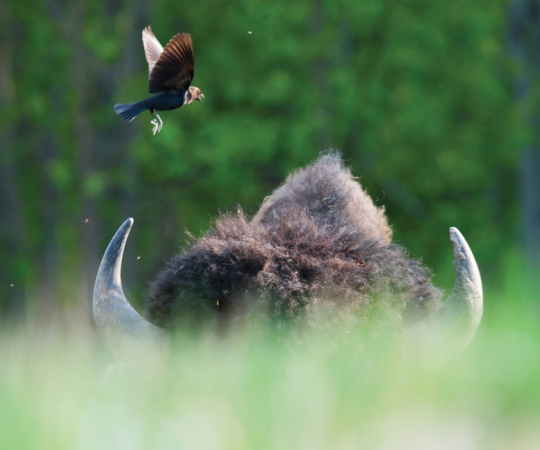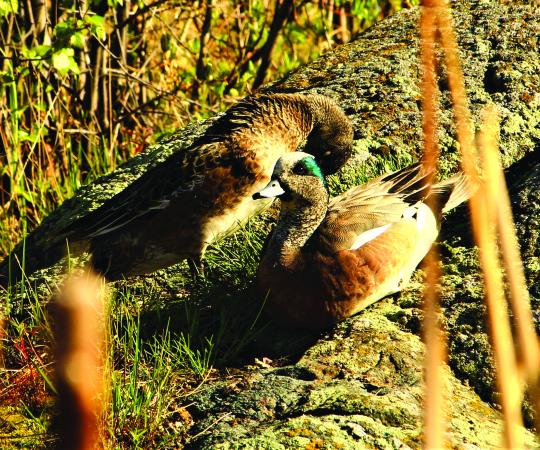You startle and stare around, sure the cries are coming from close by, but, nothing….. You scan the hills and lake margins, and finally spot them along the shore of a nearby lake. Slender silhouettes, stalking on elongated legs. They forage along the shore, and suddenly a dance breaks out with the birds leaping, twirling, and curtseying to each other.
These are sandhill cranes (Antigone canadensis, originally Grus canadensis, but revised into the genus Antigone), returning to their summer breeding grounds from migrations that often take them the length of North America from Mexico to the Arctic.
I grew up on the Texas coast, and sandhill cranes were always a familiar sight on the salt marshes and coastal prairies. On their wintering grounds, they consume small reptiles and amphibians, as well as insects, crabs, crayfish, and a variety of vegetation, including grains.
And today, I live at the other end of their migration pathways, and watch as they pass overhead in long lines, bugling to each other in aerial crane conversations. Unlike herons and egrets, cranes fly with necks stretched and legs trailing behind, with steady wingbeats.
Where there are high hills and cliffs, such as along the arctic coast, you can see the cranes circling on set wings against the spring sky, riding the thermals off the cliffs to gain altitude, and then passing from sight on a long glide without wingbeats, just subtle angling of the wings to keep them at altitude, onward to their nesting grounds on the arctic islands. Sometimes there are so many cranes utilizing the thermals that their flock actually defines the thermal, due to the circling cranes.
And where I live now at Rankin Inlet, there are many cranes in springtime, passing through with brief stops to feed along the coast, lake margins, and sedge meadows, where they pull up the succulent shoots of the sedges, or pick at last year’s berries and gobble many a hapless lemming or tundra vole.
Sandhill cranes are gorgeous birds. At 1.2 m in height, among the tallest birds in the Arctic, and among those with the greatest wingspread, about 2 m. At a distance, they seem a monotonous tannish grey, but when you see them up close, it’s apparent that they are a montage of colours, orangish covert feathers, draping “bustles” of light grey, and their base colour a rich grey brown. Bright red fleshy patches on their heads are speckled with tiny dark filo-feathers, and can flush a brighter red with excitement. Their distinctive cries are amplified by long tracheas that curl into their sternums (breastbones), helping to amplify their calls.
They are essentially living dinosaurs, among the most ancient of birds. A 10 million year-old fossil found in Nebraska may be a sandhill crane or a close ancestor. 2.5 million year-old fossils of sandhill cranes have been found in Florida.
And they are strongly family-oriented. They may live to 20-30 years, and mate for life. But, if one of the pair is lost, the other often finds another mate.
A female usually lays three faintly-spotted brownish yellow to olive eggs, in a nest of piled up vegetation along a lakeshore, but sometimes far from a shore, often on an upper slope facing a lake. The female will usually hatch only two of the eggs. The chicks are “precocial”, born able to walk, and soon leaving the nest to feed under the intensive guidance of the parents. One chick sometimes dies, usually due to predation, but cranes often raise two chicks.
Family bonds are enhanced and maintained by elaborate dances, and it is clear that the parents teach the young to dance. There are graceful bows, leaps, pirouettes, and spins, curtseys, crouch-jumps, and some tossing of bits of vegetation or feathers into the air. The chicks (sometimes called “colts”) imitate their elders, lifting their skinny, almost featherless, wings in imitation of their parents’ moves. And some of the dance moves are regional, but often conveyed across the crane universe on the staging or wintering grounds. They clearly learn from one another. No need for Tiktok.
The family stays together on migration and winters together, returning the next spring to their nesting area. Sometimes the parents drive the previous years’ young away before starting a new brood, but we’ve noticed here in the North that sometimes the family stays together through a second summer. The young usually don’t pair up until their third to fifth year.
Though there are some non-migratory populations in the southern US, including Florida, and Cuba, most sandhills migrate over long distances. Our northern sandhills migrate south to the Platte River valley in Nebraska where they gather in huge numbers; some 450,000 birds migrate through this area. Many then go on to winter along the Gulf Coast, in the Bosque del Apache National Wildlife Refuge in southern New Mexico or in the Sacramento Valley of California. Many people travel long distances to see the massive flocks of wintering cranes.
If you are watching cranes in the north, it works best to use a spotting scope, or use your vehicle as a blind, sitting quietly and watching with binoculars out a window. They will often come quite close, and a dance can break out at any time!
Dancing dinosaurs in a bouncy ballet – that will make your day!









